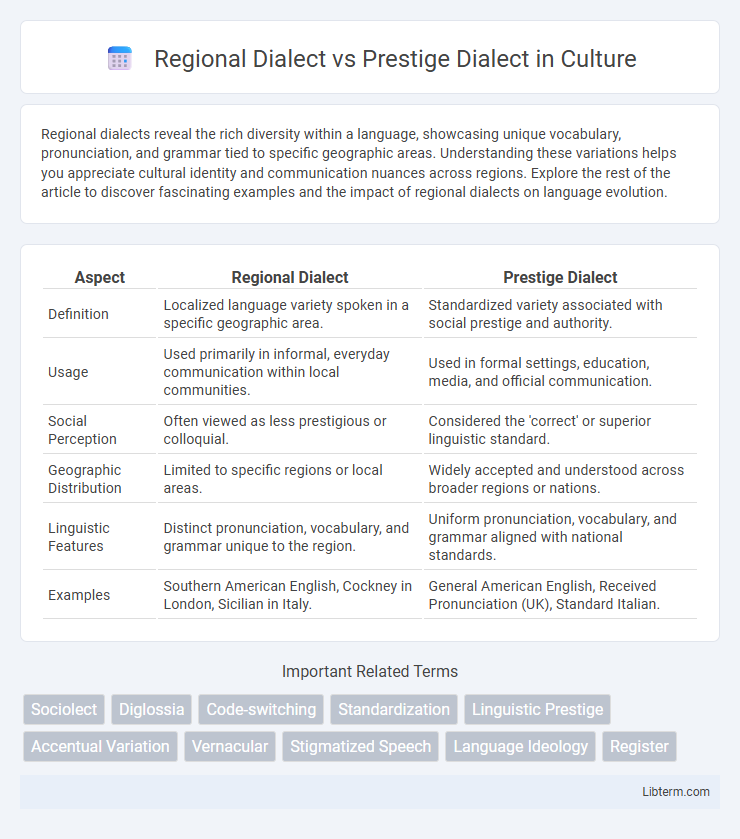Regional dialects reveal the rich diversity within a language, showcasing unique vocabulary, pronunciation, and grammar tied to specific geographic areas. Understanding these variations helps you appreciate cultural identity and communication nuances across regions. Explore the rest of the article to discover fascinating examples and the impact of regional dialects on language evolution.
Table of Comparison
| Aspect | Regional Dialect | Prestige Dialect |
|---|---|---|
| Definition | Localized language variety spoken in a specific geographic area. | Standardized variety associated with social prestige and authority. |
| Usage | Used primarily in informal, everyday communication within local communities. | Used in formal settings, education, media, and official communication. |
| Social Perception | Often viewed as less prestigious or colloquial. | Considered the 'correct' or superior linguistic standard. |
| Geographic Distribution | Limited to specific regions or local areas. | Widely accepted and understood across broader regions or nations. |
| Linguistic Features | Distinct pronunciation, vocabulary, and grammar unique to the region. | Uniform pronunciation, vocabulary, and grammar aligned with national standards. |
| Examples | Southern American English, Cockney in London, Sicilian in Italy. | General American English, Received Pronunciation (UK), Standard Italian. |
Understanding Regional Dialects
Regional dialects represent distinct variations in language use tied to specific geographical areas, characterized by unique vocabulary, pronunciation, and grammatical structures. These dialects provide valuable insights into the cultural identity and historical development of speech communities, reflecting regional traditions and social interactions. Understanding regional dialects enhances linguistic diversity appreciation and supports more accurate sociolinguistic analysis and language preservation efforts.
Defining Prestige Dialects
Prestige dialects are varieties of language considered socially superior and are often associated with higher socioeconomic status, education, and power within a community. These dialects tend to be used in formal settings, media, and institutions, reinforcing their perceived correctness and desirability. Unlike regional dialects, prestige dialects transcend geographic boundaries and influence language standards and norms nationally or even internationally.
Historical Roots of Dialect Variation
Regional dialects originate from geographical isolation and historical settlement patterns, reflecting the unique linguistic features developed within specific communities over centuries. Prestige dialects often emerge from socio-economic centers where political power, education, and cultural influence converge, shaping language use as a symbol of status and authority. Historical events such as migration, trade, and colonization play crucial roles in differentiating regional dialects from prestige dialects by influencing language contact and social stratification.
Social Status and Language Perception
Regional dialects often reflect geographic identity and are associated with specific social groups, while prestige dialects typically align with higher social status and are perceived as more socially desirable. Language perception heavily influences social mobility, as speakers of prestige dialects are frequently afforded greater respect and opportunities in education and employment. The contrast between regional and prestige dialects highlights how linguistic variation impacts social stratification and identity within communities.
Educational Impact of Dialect Differences
Regional dialects often influence students' academic performance due to variations in vocabulary, grammar, and pronunciation compared to the prestige dialect commonly used in educational settings. These dialect differences can lead to misunderstandings and lower confidence among students who speak non-prestige dialects, affecting literacy development and standardized test scores. Educators' awareness and incorporation of dialect diversity into teaching practices enhance inclusivity and improve educational outcomes for dialect-diverse learners.
Media Representation of Dialects
Media representation of regional dialects often reinforces social hierarchies by favoring prestige dialects in news broadcasts, dramas, and advertisements, which portray these accents as more credible and authoritative. This selective exposure marginalizes regional dialects, limiting their visibility and contributing to stigmatization or stereotypes associated with speakers from certain geographic areas. The dominance of prestige dialects in media shapes public perception, influencing language attitudes and impacting linguistic identity and cultural preservation.
Regional Dialects and Identity
Regional dialects play a crucial role in shaping individual and community identity by reflecting local culture, history, and social norms embedded in speech patterns. These dialects reinforce a sense of belonging and pride among speakers, distinguishing them from other groups and preserving linguistic diversity within a larger language. Linguistic features such as vocabulary, pronunciation, and grammar unique to regional dialects serve as powerful markers of regional heritage and social identity.
Language Standardization and Its Effects
Regional dialects often reflect localized linguistic features and cultural identities, while prestige dialects typically represent the standardized form endorsed by educational institutions, government, and media. Language standardization promotes uniformity by elevating prestige dialects, leading to increased social mobility for speakers of the standard variety but potentially causing stigmatization and erosion of regional dialects. This process affects linguistic diversity by marginalizing non-standard speech forms and influencing attitudes toward language correctness and identity.
Dialect Discrimination and Social Mobility
Dialect discrimination often emerges when regional dialect speakers face prejudice from those using prestige dialects, impacting their access to education, employment, and social opportunities. Prestige dialects typically align with dominant social groups, granting speakers greater social mobility and economic advantages. The stigmatization of regional dialects perpetuates social inequalities by limiting upward mobility for marginalized linguistic communities.
Preserving Linguistic Diversity
Regional dialects embody the unique cultural heritage and historical identity of specific geographic areas, playing a vital role in preserving linguistic diversity. Prestige dialects, often associated with political, economic, or educational power centers, can overshadow regional varieties, leading to dialect leveling and language homogenization. Encouraging the use and study of regional dialects supports linguistic diversity by maintaining distinct phonological, lexical, and syntactic features essential to cultural identity.
Regional Dialect Infographic

 libterm.com
libterm.com